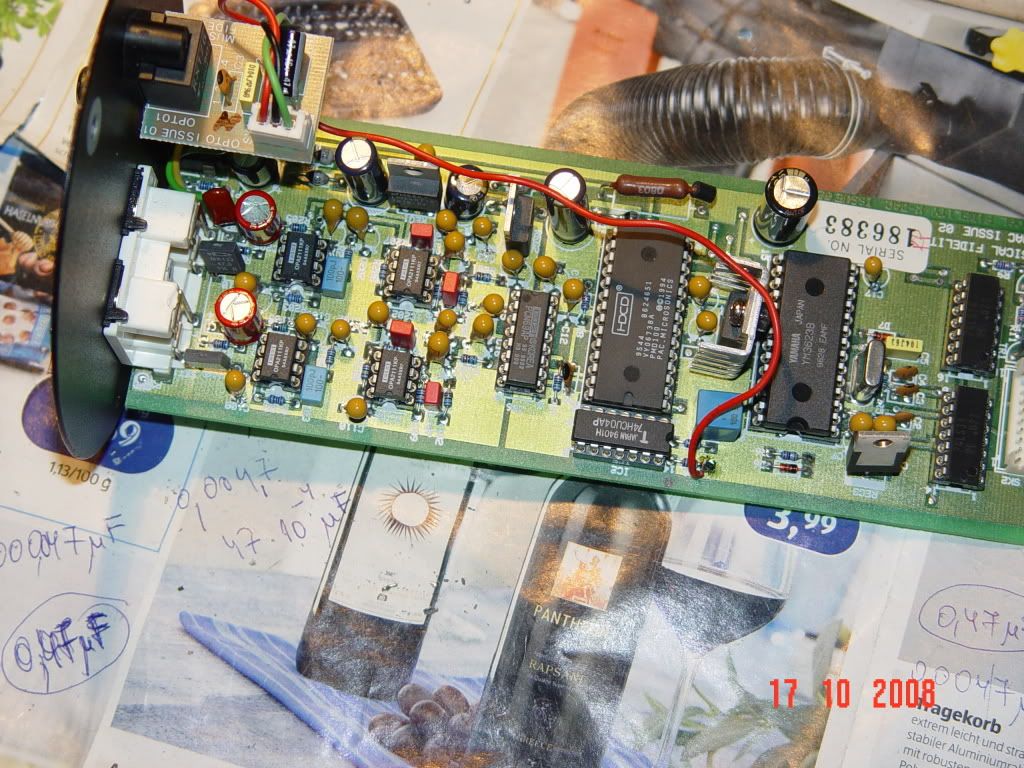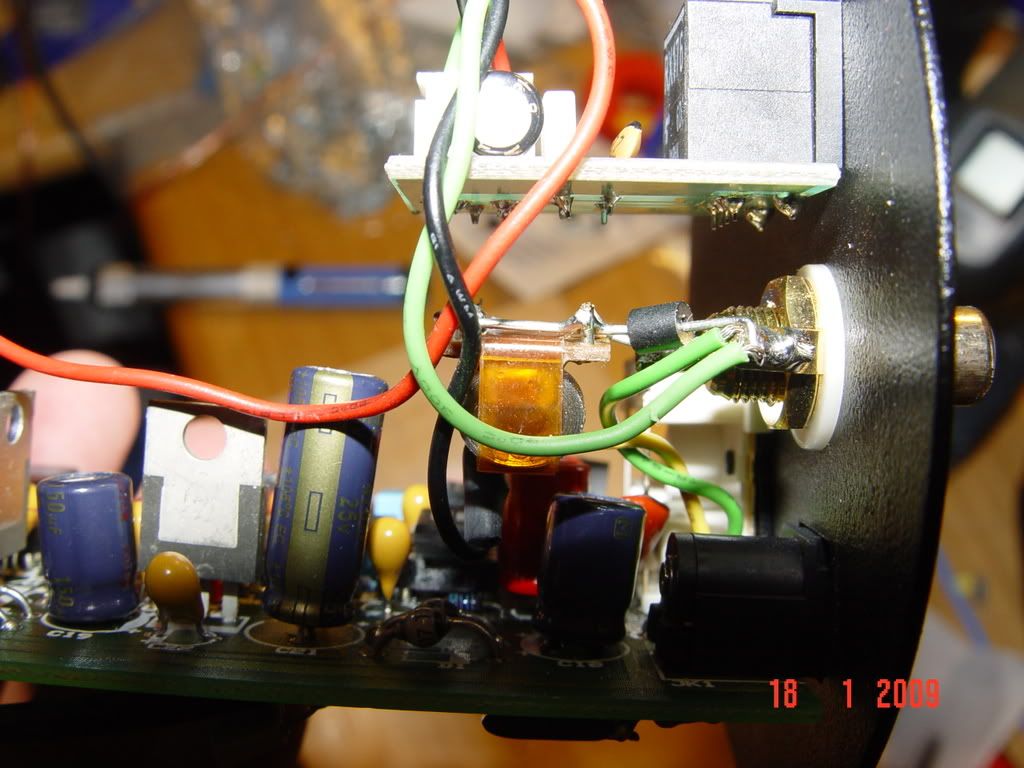leo
Been here a while!  Team wtf is it?
Team wtf is it?
Posts: 3,638
|
Post by leo on Sept 6, 2008 17:45:59 GMT
Just a note guys but if your wanting to upgrade the spdif coupling cap don't use anything physically too big, having huge great foils and long lead out wires is not the way to go for this application  If you want to try a polypropylene the Vishay 0.1uf MKP1837 are not bad and not too big either Regarding the pulse traffo, Newava S22083 are very good and have low leakage inductance. |
|
XTRProf
Fully Modded
Pssst ! Got any spare capacitors ?
Posts: 5,689
|
Post by XTRProf on Sept 7, 2008 14:32:10 GMT
Just a note guys but if your wanting to upgrade the spdif coupling cap don't use anything physically too big, having huge great foils and long lead out wires is not the way to go for this application  If you want to try a polypropylene the Vishay 0.1uf MKP1837 are not bad and not too big either Don't worry, the compactness of the V2 and V3 will see to that from all fancy imagination.  |
|
|
|
Post by dejanm on Sept 7, 2008 19:50:31 GMT
Just a note guys but if your wanting to upgrade the spdif coupling cap don't use anything physically too big, having huge great foils and long lead out wires is not the way to go for this application  If you want to try a polypropylene the Vishay 0.1uf MKP1837 are not bad and not too big either Regarding the pulse traffo, Newava S22083 are very good and have low leakage inductance. Interesting ... I ordered yesterday from RS Components these Vishays because of their low tolerance of only 1%. In the same time, they are made especially for digital, clock, etc. applications. There are 3 caps in X-DAC V2 which are very good candidates to be replaced by these Vishays: one is coupling cap on SPDIF line; second one is in optical curcuit and the third one is a part of clock circuit. The value that I ordered is 0,1 uF, 100V. For the pulse transformer I selected Lundahl LL1572. Tomorrow I will execute the payment ... Thank you a lot guys for your help ... As soon as these things come I will install them ... |
|
|
|
Post by dejanm on Oct 17, 2008 17:27:39 GMT
I did a second round of upgrades of this DAC. First, I replaced existing resistor in a clock supply path with Mills MRA-5 2,2 ohm, 5W.  Then I replaced all 2,2 nF (with WIMA) and 100 pF (with Evox-Rifa) caps in the output stage. I also replaced decoupling cap in the digital input path with already mentioned Vishay of 0,1 uF, 100V. You can see it in the lower right corner of the picture. It is a bit larger than the others and it is blue.  Not a big improvement though - at least not at first listen. Now I am planning for the upgrade number 3 to insert impuls transformer at the digital input. |
|
|
|
Post by dejanm on Jan 18, 2009 15:34:58 GMT
It took me a while to insert the input transformer but now it is done and I am writing this after the first listening session. I bought Lundahl LL1527 and insert it immediately after the coax input. In that way I separated that digital input galvanically. Here are some pics:  You can see that the small transformer is hanging on two rods (former cap legs) that are in the same time its connections to the digital input. The top Optical input board has been first removed (there I changed two caps also). This is how it looks like when optical input board is put back in place:  First listening impressions are positive although the difference is not day/night ... It seems that this change improved bass reproduction of this DAC without degrading the rest of musical image. The final result seems more balanced than before with slightly deeper and clearer bass reproduction. Is it worth 30 euros (cost of the transformer + shipping costs) ? I would say yes ... I expect that after a while and some more listening that the impact of this change will be even greater (usually transformers do need some time to sound at its best). |
|
Deleted
Deleted Member
Posts: 0
|
Post by Deleted on Jan 18, 2009 21:17:32 GMT
dejanm Did you check the specifications of that transformer ? It falls far short of being a good match for a 75ohm digital output, and although it may work reasonably well with 44.1KHZ, it certainly isn't what I would use for higher sampling rates. You may have been better off getting a transformer of the type that the X-DAC V3 etc. use, which are designed for SPDIF applications. One could perhaps be mounted on a small piece of veroboard ? www.lundahl.se/pdfs/datash/1527_7xl.pdfSandyK |
|
|
|
Post by dejanm on Jan 18, 2009 22:09:58 GMT
SandyK,
I am not sure that I know what you really mean ? V2 supports only 44,1 and 48 KHz if that is an issue ...
|
|
|
|
Post by dejanm on Jan 19, 2009 8:41:07 GMT
SandyK,
If you mean that Lundahl LL1566 would be a better choice - I fully agree. I cannot remember any more why I selected the older version ... But you are right - LL1566 would be a better choice ...
For these old chaps like mine V2, LL1527 is working fine though ...
|
|
Deleted
Deleted Member
Posts: 0
|
Post by Deleted on Jan 19, 2009 8:53:33 GMT
dejan
The Lundahl LL1566,or something similar , would be a far better choice. I would expect further improvements by using a wideband pulse transformer, instead of a transformer designed for general audio use. The input waveform to the DAC would be much better, and need less re-shaping for reliable triggering. This should translate to better performance.
Alex
|
|
|
|
Post by dejanm on Jan 19, 2009 10:02:33 GMT
Sandy K.
You are probably right. LL1566 looks much better - at least on the paper. I guess that for modern DACs it would make difference. I do not think that I will go now for that one after installing this older one, but the general recommendation for all others, who would like to play with input impulse transformers, is definitely to go for new versions like LL1566 ...
Thanks for this remark ...
|
|
|
|
Post by dejanm on Jan 19, 2009 12:21:24 GMT
Maybe at the end to comment on all these changes and what are my experiences with them ... I would try to be rather brief ...
1.) I believe that the most important change - the change that had the most impact on sound of reproduction - was the exchange of electrolytics in the power supply. Especially it was important to change the 1000 uF, 16V elco responsible for clock circuit supply. I put here Panasonic FM, which is really good, but now I am sorry that I didn't try here BalckGate Standard ...
2.) I changed the OPAs having 2604 as a first upgrade and then I switched to 2111. These are really good - no DC offset, very silent, much better sound. This is a strong recommendation ...
3.) Two changes brought subtle but remarkable changes in sound: exchange of resistor for clock circuit supply and inserting input transformer for coax input.
4.) All other changes brought very subtle if any improvements to the sound reproduction. I wouldn't recommend them as something that is "must do" ...
Further possible improvements: above all the usage of better regulators. I was thinking a lot about this step ... The main problem with this idea is the lack of space to implement them. Therefore I am probably not going after it although there is a possible solution even for this problem. There are companies in internet that are selling regulators which are in reality assembled PCBs with 3 pins, so that it can be pluged directly to the PCB instead of one already existing LM chip. Dimensions and voltages on offer are ok, the price is somewhere about 30 euros a piece ... I do not know anything about their quality. This could be though the way to proceed, because obviously the playing with power supply paid its dividends. Much more than for example putting the BlackGate Nx on the signal path instead of old, no-name, tantalium cap (surprise, surprise, ... ).
If the costs are an issue then I would stick with only two first mentioned changes and the improvement will be easy to hear ...
At this moment I am very much surprised how much it was possible to get out of this DAC without changing anything in its design. Buying it cheap on eBay, and sticking with only these most important changes, could bring you very, very decent DAC for a quite small amount of money. Unfortunately, I do not have anything to directly compare it and therefore I cannot say anything concretely about its positioning on the market, but believe me, this thing is sounding good ...
|
|
|
|
Post by dejanm on Jan 26, 2009 10:34:20 GMT
SandyK, If you mean that Lundahl LL1566 would be a better choice - I fully agree. I cannot remember any more why I selected the older version ... But you are right - LL1566 would be a better choice ... For these old chaps like mine V2, LL1527 is working fine though ... Sorry guys ... I made mistake ... It is not LL1527 but Lundahl LL 1572 that I installed in this unit. Sorry for confusion once again ... |
|
robertkd
Been here a while!  Electronics Engineer from sunny Queensland
Electronics Engineer from sunny Queensland
Posts: 111
|
Post by robertkd on Jan 26, 2009 11:03:18 GMT
now that makes more sense  |
|